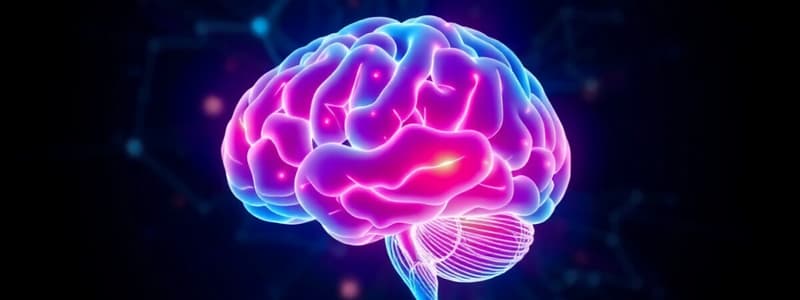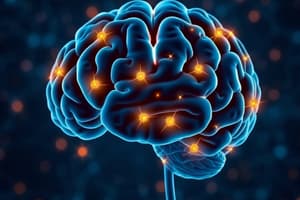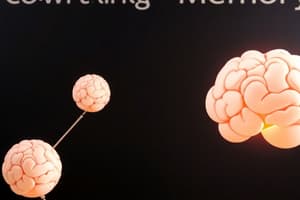Podcast
Questions and Answers
Which scenario exemplifies the central executive's role in working memory?
Which scenario exemplifies the central executive's role in working memory?
- Repeating a phone number silently to remember it.
- Solving a complex math problem by mentally manipulating equations. (correct)
- Recalling a vivid childhood memory triggered by a familiar scent.
- Recognizing a familiar face in a crowd.
How does the concept of 'cognitive control' relate to working memory?
How does the concept of 'cognitive control' relate to working memory?
- It refers to the passive storage of information in short-term memory.
- It solely relies on the phonological loop for auditory processing.
- It describes the manipulation and application of working memory for complex tasks. (correct)
- It is independent of executive functions like planning and task switching.
What distinguishes working memory from the older concept of short-term memory?
What distinguishes working memory from the older concept of short-term memory?
- They are identical terms referring to the same cognitive processes with no differences.
- Short-term memory has a larger capacity than working memory, allowing for more information to be stored.
- Working memory involves active manipulation of information, while short-term memory focuses on passive storage. (correct)
- Short-term memory includes cognitive control, while working memory only stores information passively.
Which task would be most challenging for someone with a compromised phonological loop?
Which task would be most challenging for someone with a compromised phonological loop?
In the context of working memory, what does the 'phonological similarity effect' reveal?
In the context of working memory, what does the 'phonological similarity effect' reveal?
What role does the episodic buffer fulfill within the working memory model?
What role does the episodic buffer fulfill within the working memory model?
How does the Stroop task demonstrate the role of working memory in stimulus attention and response inhibition?
How does the Stroop task demonstrate the role of working memory in stimulus attention and response inhibition?
What is the primary function of the central executive in working memory?
What is the primary function of the central executive in working memory?
How would increasing the 'N' value in an N-back task affect its difficulty and what cognitive process does this primarily test?
How would increasing the 'N' value in an N-back task affect its difficulty and what cognitive process does this primarily test?
Which of the following illustrates the visuospatial sketchpad in action?
Which of the following illustrates the visuospatial sketchpad in action?
How does 'executive function' relate to the everyday action of planning a route to a new destination?
How does 'executive function' relate to the everyday action of planning a route to a new destination?
If someone is multi-tasking, which component of working memory is most heavily utilized?
If someone is multi-tasking, which component of working memory is most heavily utilized?
What might be a real-world implication of a deficit in working memory capacity?
What might be a real-world implication of a deficit in working memory capacity?
Compared to someone performing a simple digit span test (remembering a sequence of numbers), what additional cognitive demand is placed on someone performing a backward digit span test (remembering and recalling the numbers in reverse order)?
Compared to someone performing a simple digit span test (remembering a sequence of numbers), what additional cognitive demand is placed on someone performing a backward digit span test (remembering and recalling the numbers in reverse order)?
In what scenario would the use of chunking (grouping individual pieces of information together) be least effective for improving working memory performance?
In what scenario would the use of chunking (grouping individual pieces of information together) be least effective for improving working memory performance?
Flashcards
Short-Term Memory
Short-Term Memory
Memory system holding information briefly.
Working Memory
Working Memory
A system for temporary storage and manipulation of information for complex tasks.
Cognitive Control
Cognitive Control
Manipulation and application of working memory for planning, task switching, and attention.
Phonological Loop
Phonological Loop
Signup and view all the flashcards
Visuospatial Sketchpad
Visuospatial Sketchpad
Signup and view all the flashcards
Episodic Buffer
Episodic Buffer
Signup and view all the flashcards
Phonological Similarity Effect
Phonological Similarity Effect
Signup and view all the flashcards
Central Executive
Central Executive
Signup and view all the flashcards
Central Executive Functions
Central Executive Functions
Signup and view all the flashcards
N-Back Task
N-Back Task
Signup and view all the flashcards
Stroop Task
Stroop Task
Signup and view all the flashcards
Response Inhibition
Response Inhibition
Signup and view all the flashcards
Study Notes
- Short-term memory (STM) holds information for a short period.
- Working memory temporarily stores and manipulates information for complex activities.
- Cognitive control, also known as executive control or executive function, involves using working memory for planning, task switching, attention, stimulus selection, and inhibiting inappropriate behaviors.
- Working memory can be considered a dynamic version of STM.
- Short-term memory and working memory refer to the same cognitive processes
- Working memory is an updated view of short-term memory.
Working Memory Components
- Phonological loop maintains auditory memories through internal speech rehearsal.
- Visuospatial sketchpad holds and manipulates visual and spatial images.
- Episodic buffer integrates information across the phonological loop, visuospatial sketchpad, and long-term memory for a short duration.
Phonological Loop Evidence
- Phonological similarity effect: Immediate serial recall of verbal material is reduced when items sound alike.
- This effect occurs because working memory relies on sound-based representation, causing confusion during retrieval when sounds are similar, such as mistaking "mad, can, man, mat, cap" compared to memorizing "big, wide, large, high, tall".
- The phonological similarity effect diminishes with longer lists and multiple learning trials as long-term memory and meaning become more important.
Central Executive
- Central executive monitors and manipulates working-memory buffers, providing cognitive control.
- Manipulations of the central executive includes:Adding to and deleting items in buffers and selecting items to guide behavior.
- The central executive is the "working" component of working memory.
- The central executive updates working memory by receiving and evaluating sensory information.
- It moves items into and retrieves them from long-term memory.
- It decides which memories are needed for specific tasks.
N-Back Task
- The N-back task consists of a subject being read a random list of items.
- The subject responds with the number read N numbers previously when the "target" is read.
- Success requires keeping track of the last N numbers read.
Stimulus Attention and Response Inhibition
- Stroop task involves response interference from naming the ink color of a written color name.
- Example: The word "BLUE" is printed in red ink, and participants are asked to say the ink color ("red").
- The Stroop task needs inhibiting automatic responses while attending to task-specific aspects of a stimulus.
- The Stroop task illustrates competition within the brain for behavioral and thought control.
Studying That Suits You
Use AI to generate personalized quizzes and flashcards to suit your learning preferences.




